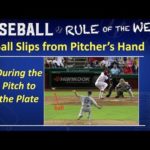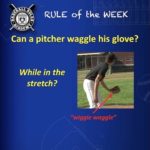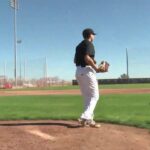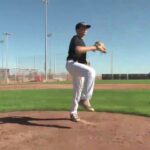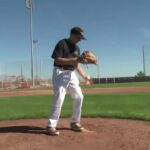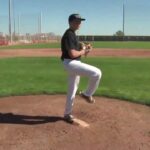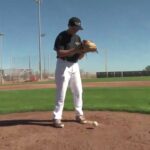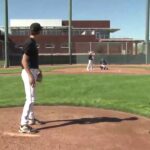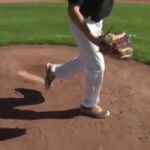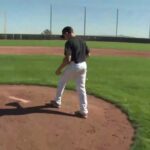5.07 Pitching
(a) Legal Pitching Delivery
There are two legal pitching positions, the Windup Position and the Set Position, and either position may be used at any time. Pitchers shall take signs from the catcher while in contact with the pitcher’s plate.
Rule 5.07(a) Comment:
Pitchers may disengage the rubber after taking their signs but may not step quickly onto the rubber and pitch. This may be judged a quick pitch by the umpire. When the pitcher disengages the rubber, he must drop his hands to his sides. Pitchers will not be allowed to disengage the rubber after taking each sign. The pitcher may not take a second step toward home plate with either foot or otherwise reset his pivot foot in his delivery of the pitch. If there is a runner, or runners, on base it is a balk under Rule 6.02(a); if the bases are unoccupied it is an illegal pitch under Rule 6.02(b).
(1) The Windup Position
The pitcher shall stand facing the batter, his pivot foot in contact with the pitcher’s plate and the other foot free. From this position any natural movement associated with his delivery of the ball to the batter commits him to the pitch without interruption or alteration. He shall not raise either foot from the ground, except that in his actual delivery of the ball to the batter, he may take one step backward, and one step forward with his free foot. When a pitcher holds the ball with both hands in front of his body, with his pivot foot in contact with the pitcher’s plate and his other foot free, he will be considered in the Windup Position.
Rule 5.07(a)(1) Comment:
In the Windup Position, a pitcher is permitted to have his “free” foot on the rubber, in front of the rubber, behind the rubber or off the side of the rubber.
From the Windup Position, the pitcher may:
(A) deliver the ball to the batter, or
(B) step and throw to a base in an attempt to pick-off a runner, or
(C) disengage the rubber (if he does he must drop his hand
to his sides). In disengaging the rubber the pitcher must step off with his pivot foot and not his free foot first. He may not go into a set or stretch position—if he does it is a balk.
(2) The Set Position
Set Position shall be indicated by the pitcher when he stands facing the batter with his pivot foot in contact with, and his other foot in front of, the pitcher’s plate, holding the ball in both hands in front of his body and coming to a complete stop. From such Set Position he may deliver the ball to the batter, throw to a base or step backward off the pitcher’s plate with his pivot foot. Before assuming Set Position, the pitcher may elect to make any natural preliminary motion such as that known as “the stretch.” But if he so elects, he shall come to Set Position before delivering the ball to the batter. After assuming Set Position, any natural motion associated with his delivery of the ball to the batter commits him to the pitch without alteration or interruption. Preparatory to coming to a set position, the pitcher shall have one hand on his side; from this position he shall go to his set position as defined in Rule 5.07(a)(2) without interruption and in one continuous motion. The pitcher, following his stretch, must (a) hold the ball in both hands in front of his body and (b) come to a complete stop. This must be enforced. Umpires should watch this closely. Pitchers are constantly attempting to “beat the rule” in their efforts to hold runners on bases and in cases where the pitcher fails to make a complete “stop” called for in the rules, the umpire should immediately call a “Balk.”
Rule 5.07(a)(2) Comment:
With no runners on base, the pitcher is not required to come to a complete stop when using the Set Position. If, however, in the umpire’s judgment, a pitcher delivers the ball in a deliberate effort to catch the batter off guard, this delivery shall be deemed a quick pitch, for which the penalty is a ball. See Rule 6.02(a)(5) Comment. With a runner or runners on base, a pitcher will be presumed to be pitching from the Set Position if he stands with his pivot foot in contact with and parallel to the pitcher’s plate, and his other foot in front of the pitcher’s plate, unless he notifies the umpire that he will be pitching from the Windup Position under such circumstances prior to the beginning of an at-bat. A pitcher will be permitted to notify the umpire that he is pitching from the Windup Position within an at-bat only in the event of (i) a substitution by the offensive team; or (ii) immediately upon the advancement of one or more runners (i.e., after one or more base runners advance but before the delivery of the next pitch).
(b) Warm-Up Pitches
When a pitcher takes his position at the beginning of each inning, or when he relieves another pitcher, he shall be permitted to pitch preparatory pitches to his catcher during which play shall be suspended. A league by its own action may limit the number of preparatory pitches and/or may limit the amount of time such preparatory pitches may consume. If a sudden emergency causes a pitcher to be summoned into the game without any opportunity to warm up, the umpire-in-chief shall allow him as many pitches as the umpire deems necessary.
(c) Pitcher Delays
When the bases are unoccupied, the pitcher shall deliver the ball to the batter within 12 seconds after he receives the ball. Each time the pitcher delays the game by violating this rule, the umpire shall call “Ball.” The 12-second timing starts when the pitcher is in possession of the ball and the batter is in the box, alert to the pitcher. The timing stops when the pitcher releases the ball. The intent of this rule is to avoid unnecessary delays. The umpire shall insist that the catcher return the ball promptly to the pitcher, and that the pitcher take his position on the rubber promptly. Obvious delay by the pitcher should instantly be penalized by the umpire.
(d) Throwing to the Bases
At any time during the pitcher’s preliminary movements and until his natural pitching motion commits him to the pitch, he may throw to any base provided he steps directly toward such base before making the throw.
Rule 5.07(d) Comment:
The pitcher shall step “ahead of the throw.” A snap throw followed by the step directly toward the base is a balk.
(e) Effect of Removing Pivot Foot From Plate
If the pitcher removes his pivot foot from contact with the pitcher’s plate by stepping backward with that foot, he thereby becomes an infielder and if he makes a wild throw from that position, it shall be considered the same as a wild throw by any other infielder.
Rule 5.07(e) Comment:
The pitcher, while off the rubber, may throw to any base. If he makes a wild throw, such throw is the throw of an infielder and what follows is governed by the rules covering a ball thrown by a fielder.
(f ) Ambidextrous Pitchers
A pitcher must indicate visually to the umpire-in-chief, the batter andany runners the hand with which he intends to pitch, which may be done by wearing his glove on the other hand while touching the pitcher’s plate. The pitcher is not permitted to pitch with the other hand until the batter is retired, the batter becomes a runner, the inning ends, the batter is substituted for by a pinch-hitter or the pitcher incurs an injury. In the event a pitcher switches pitching hands during an at-bat because he has suffered an injury, the pitcher may not, for the remainder of the game, pitch with the hand from which he has switched. The pitcher shall not be given the opportunity to throw any preparatory pitches after switching pitching hands. Any change of pitching hands must be indicated clearly to the umpire-in-chief.




